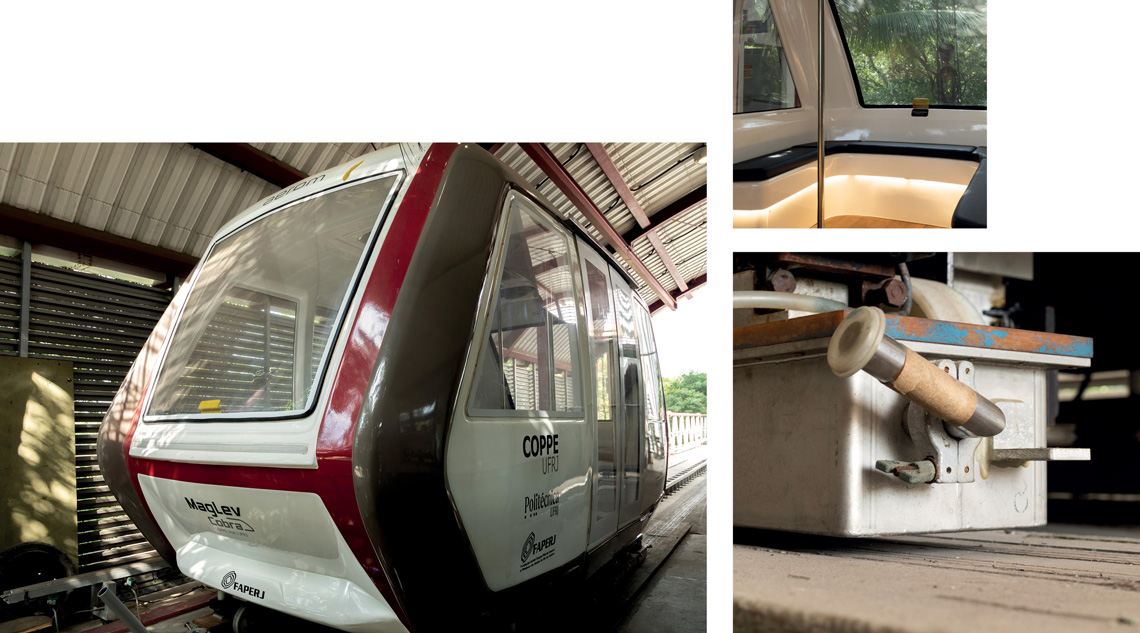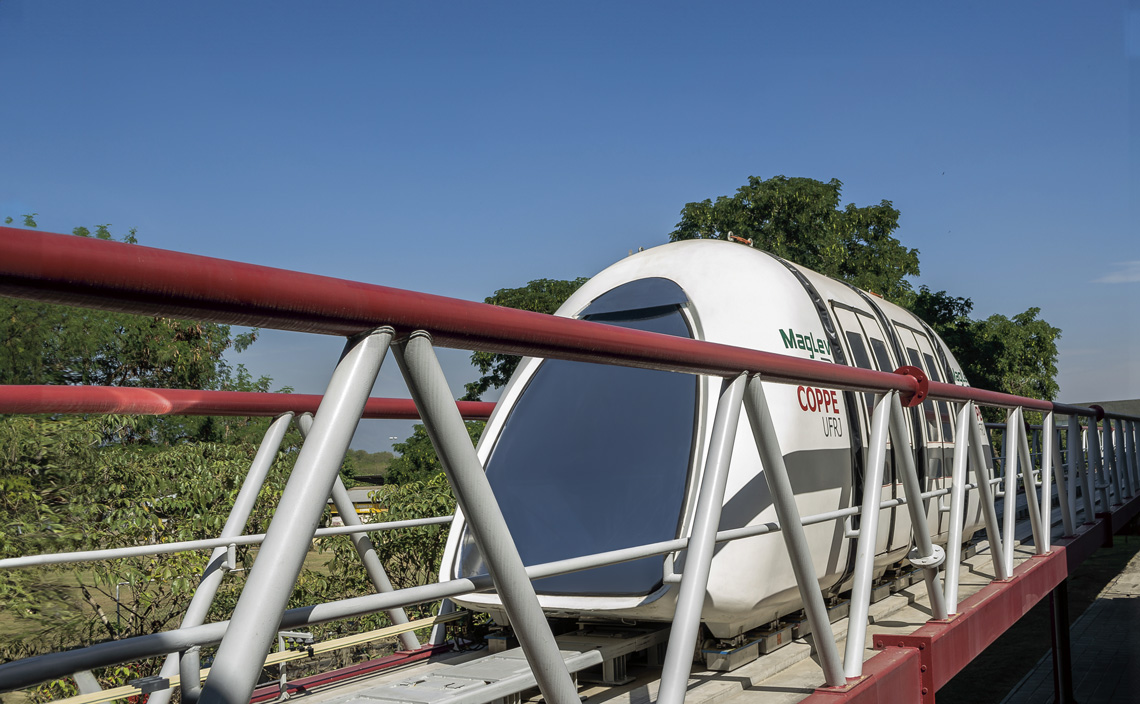Brazil is taking another step forward in the development of a magnetic levitation train (maglev). These futuristic vehicles, which are still rare worldwide, hover a few centimeters above the track, moving silently and emitting no direct pollutants because they are powered by electricity. By the end of the year, researchers at the Federal University of Rio de Janeiro (UFRJ) plan to begin a new testing phase of the world’s first full-scale experimental vehicle equipped with superconducting magnetic levitation (SML) technology. The train car, which is 4.3 meters (m) long, 2 m wide, and can hold 20 passengers, will travel on a 200 m elevated track between UFRJ Technology Centers 1 and 2, on Ilha do Fundão in the city of Rio de Janeiro.
The only existing operational maglevs are in Japan, China, and South Korea. Research into the vehicles is also being carried out in Germany, the USA, France, England, Russia, and Italy. The SML system is one of three maglev technologies with promise for mass transit. The other two, electrodynamic and electromagnetic levitation, are older.
Brazil’s MagLev Cobra project is led by professors from UFRJ’s Alberto Luiz Coimbra Institute for Engineering Research and Graduate Studies (COPPE), in partnership with the university’s Polytechnic School and the Physics Institute. The research began in 1998 (see Pesquisa FAPESP issue nº 157) and is funded by the Rio de Janeiro State Research Foundation (FAPERJ), the Brazilian Development Bank (BNDES), and the Brazilian Funding Authority for Studies and Projects (FINEP). Three patents have already been granted by the country’s National Institute of Industrial Property (INPI).
A first prototype of the vehicle, built by hand, was run on the same 200 m track as an experiment between 2015 and 2020. “Twenty thousand people were transported during the period,” says Richard Magdalena Stephan, an electrical engineer from COPPE’s Electrical Engineering Program and head of MagLev Cobra development. The results of the first year of testing were published in the scientific journal IEEE Transactions on Applied Superconductivity in 2016.
The latest version of the train was manufactured by Rio Grande do Sul–based company Aerom. “It was made via an industrial production process. If we need to build a second identical vehicle, we can do so. With the previous prototype, that would have been impossible,” explains the engineer. The latest version has some new features, including driverless operation, automatic door opening and closing, and better thermal and acoustic insulation.
Stability in levitation
The superconducting levitation technology used by the MagLev Cobra takes advantage of the properties of a group of new materials that were first produced at the end of the twentieth century. The trains contain a ceramic made of yttrium, barium, and copper oxide, and the rails are rare-earth magnets—composed of neodymium-iron-boron alloys — as explained by Stephan and colleagues in a paper published in the journal Electronics in 2020. When cooled to negative 196 degrees Celsius (oC) with liquid nitrogen, the ceramic becomes superconducting and repels the magnetic field produced by the magnets. Diamagnetism — the property of repelling a magnetic field — generates a force between the superconductor and the magnet, which is what makes the train levitate.

The new version of the COPPE vehicle was industrially produced; the passenger cabins (left) and the cryostat (below), which replaces the train wheel
In place of the wheels found on a traditional train is a cryostat, a thermal device shaped like a rectangular box that cools the ceramic. “The repulsion between the high-temperature superconducting [HTS] materials and rare-earth magnets generates a stable levitation force that is not easily broken,” explains the COPPE professor. This means that a convoy of maglev vehicles using SML technology can stably negotiate even sharp curves.
The MagLev Cobra, the final version of which will be composed of articulated rail cars, will levitate 1 cm above the track. It will be driven by an electric linear induction motor installed along the center of the entire track. The armature is installed on the train, while the rectifier is laid along the length of the track, in line with the position of the armature on the train—normally, electric motors are arranged circularly around an axis and operate through rotation. A power supply system supplies energy to the motor, which functions via moving contact between the armature and the rotor. Since the levitation system does not generate friction, the traction only has to combat friction from the air, which is reduced at low speeds. Energy consumption is therefore low. The energy used to power the MagLev Cobra engine will be generated by solar panels.
The testing phase for the new vehicle is expected to last at least a year. Afterwards, the UFRJ team plans to build a 1 km track with curves with radii of 50 m and slopes of up to 15%. The vehicle will be able to reach 70 km/h—the current version travels at a maximum of 12 km/h. “After these tests, if everything goes well, we will be ready for commercial operation,” says Stephan. The vehicle must be able to travel on a continuous elevated track. “If it was at ground level, it would have to be on its own track,” says the researcher.
Civil engineer Rômulo Dante Orrico Filho, former deputy municipal secretary of transport for Rio de Janeiro and a professor of transportation engineering at COPPE who did not participate in the project, believes MagLev Cobra presents significant advantages that justify public funding and investment.
“The operating cost, which involves energy expenditure and maintenance, is lower than wheeled rail vehicles,” points out the engineer. Another advantage, Orrico Filho highlights, is its lightness, since it does not require steel rails and wheels. “The infrastructure to support the track is lighter,” he says.
Electrical engineer José Roberto Cardoso, head of the Applied Electromagnetism Laboratory (LMAG) at the Polytechnic School of the University of São Paulo (USP), sees MagLev Cobra as a unique alternative for low-speed transport using magnetic levitation. “The project is original and has made great progress over the last 20 years. It is ideal for journeys within cities, at airports, and between nearby towns,” he says.
Chinese experience
Studies on magnetic levitation for passenger transport date back to the beginning of the twentieth century. In 1912, French American inventor Emile Bachelet (1863–1946) filed the first patent for electrodynamic levitation (EDL). Electromagnetic levitation (EML) was later proposed by the German engineer Hermann Kemper (1892–1977) in 1934. It was only in the 1970s that work first began on developing maglev trains.
The science behind SML technology is more recent, from the late 1980s. Outside Brazil, most SML projects are in the laboratory testing phase. The most advanced was a prototype tested at Southwest Jiaotong University (SWJTU) in Chengdu, China, in 2021, six years after tests began on Brazil’s MagLev Cobra prototype. The Chinese project is aiming to provide high-speed transport between cities, while the UFRJ project is focused on urban transit.
The SWJTU prototype test took place on a 165 m track. According to mechanical engineer Zigang Deng, head of the HTS maglev technologies team at SWJTU, a new 1.6 km test line is planned to begin operating in 2025. “We want to reach speeds of over a thousand km/h,” Deng informed Pesquisa FAPESP. “The technology for running an SML maglev at low speeds is fully developed and has been demonstrated by the UFRJ team,” says Deng. It is for that reason, he explains, that SWJTU chose to focus its project on high-speed applications.

TPG/Getty Images | Xiaoyang Liu / Construction Photography/Avalon/Getty ImagesMagnetic levitation vehicles in operation in Chengdu (left) and Shanghai (right), ChinaTPG/Getty Images | Xiaoyang Liu / Construction Photography/Avalon/Getty Images
With electrodynamic levitation, the magnets are installed on the train and the tracks are normal conductors. To create a repulsive force strong enough to support the cars, the rails need to be subjected to a rapidly varying magnetic field. Levitation therefore only occurs when the train is travelling at relatively high speeds.
The first demonstration EDL line was built in Japan in 1997. Another 42.8 km test track was built in Yamanashi, located between Tokyo and Osaka, in 2013. Two years later, the maglev vehicle achieved a world record speed of 603 km/h. “Electrodynamic levitation is a technology designed for high-speed vehicles. Levitation only occurs after reaching 100 km/h,” explains Stephan.
Electromagnetic levitation, meanwhile, uses the attractive forces between electromagnets installed in the vehicles in place of wheels and ferromagnetic materials on the tracks. The technology is suitable for both long journeys, during which trains reach higher speeds, and for shorter urban routes. A high-speed vehicle based on German technology has been traveling the 30 km distance between the airport and the city center of Shanghai, China, since 2003, reaching speeds of up to 450 km/h — the first commercial operation of a high-speed magnetic levitation vehicle.
In addition, there are currently five urban maglev vehicles in operation worldwide, all using EML: three in China, one in Japan and one in South Korea. “Due to the high speeds they reach, magnetic levitation trains could become an option in the future for connecting Asia and Europe by land,” says USP’s Cardoso.
A scientific paper published in Modern Transportation Systems and Technologies by Stephan and Deng in 2023 highlighted the advantages of SML over EML technology, which is also intended for urban transit. “Electromagnetic levitation requires an uninterrupted power supply. Electricity supply failures lead to the collapse of the levitation system,” he says. As a consequence, EML vehicles need energy backup systems and sensors. With SML technology, the only thing needed to keep the train levitating is to refill the cryostat with liquid nitrogen once a day.
Another difference is that EML vehicles use heavy electromagnets, while the SML system’s cryostats weigh less. The third distinction between the two technologies is the railroad switch mechanism. When an EML maglev vehicle needs to change track, the track itself needs to be moved to allow the vehicle to travel in a new direction. For SML vehicles, the electromagnets in the track simply need to be energized in the direction the train wants to go, cutting off the electrification of one track and switching it on for the other. “These features make SML systems light, practical, and reliable,” explains Stephan.
The story above was published with the title “A floating train” in issue 342 of august/2024.
Scientific articles
MATTOS, L. S. et al. MagLev-Cobra operational tests. IEEE Transactions on Applied Superconductivity. Vol. 26, no. 3. Apr. 2016.
STEPHAN, R. M. & PEREIRA JR., A. O. The vital contributions of maglev vehicles for the mobility in smart cities. Electronics. June 11, 2020.
STEPHAN, R. M et al. Past, present and future of superconducting magnetic levitation (SML). Modern Transportation Systems and Technologies. Vol. 9, no. 1. Nov. 2023.
